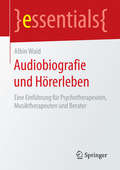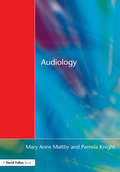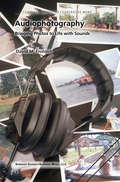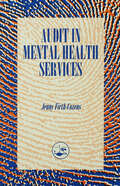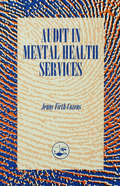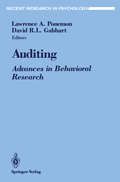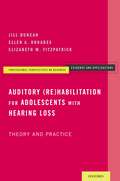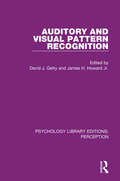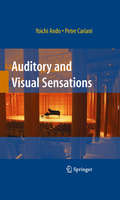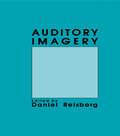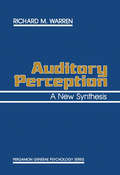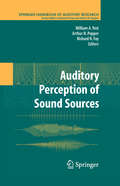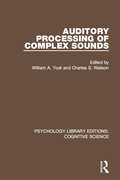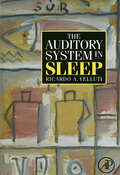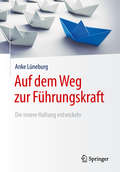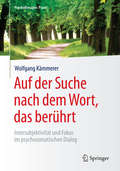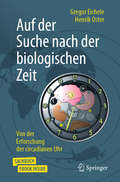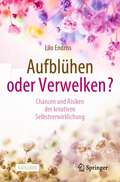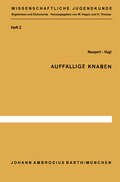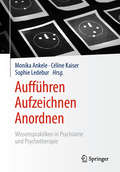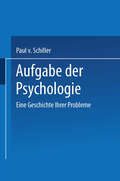- Table View
- List View
Audiobiografie und Hörerleben: Eine Einführung für Psychotherapeuten, Musiktherapeuten und Berater (essentials)
by Albin WaidIn diesem essential lernen Sie die Grundlagen einer Psychologie des Hörens kennen. Dabei erfahren Sie, wie sich die Wahrnehmung von Musik und Klang in Alltag und Biografie beschreiben und für Therapie und Beratung als Ressource nutzbar machen lässt. Von den frühesten audiobiografischen Erfahrungen bis hin zur Vielfalt des Hörens im Erwachsenenalter beschreibt der Autor in ‚Audiobiografie und Hörerleben‘ wichtige Stadien der Entwicklung des Hörens und regt Sie zugleich dazu an, die eigene Audiobiografie zu reflektieren sowie die Bedeutung des Hörens für den Menschen in Alltag und Biografie besser zu verstehen.
Audiology: An Introduction for Teachers & Other Professionals
by Pamela Knight Mary Anne MaltbyThis book is an introduction to audiology for those who have little or no knowledge of the subject. It introduces basic aspects of audiology in a clear and accessible way. This initial knowledge is then developed to a depth which allows the reader to access more specialised journals and textbooks.
Audiology: An Introduction for Teachers & Other Professionals
by Pamela Knight Mary Anne MaltbyThis book is an introduction to audiology for those who have little or no knowledge of the subject. It introduces basic aspects of audiology in a clear and accessible way. This initial knowledge is then developed to a depth which allows the reader to access more specialised journals and textbooks.
Audiophotography: Bringing Photos to Life with Sounds (Computer Supported Cooperative Work #3)
by David M. FrohlichIf you read the history of any new communication medium such as the cinema, television or radio, it always happens to be bound up with advances in some underlying technology. For example, cinema was born out of the rapid projection of a series of still images on a celluloid film strip. The difficulty of synchronizing sound recordings with the resulting moving images led to about 30 years of silent films - until such time as the technical problems were solved. In between the inventions, media seem to grow and develop at a slower pace, as content producers and consumers experiment with the most satisfactory and stimulating ways of communicating with each other. In the same example, silent film-makers eventually found ways of adding dialogue through scene titles and having music played during the projection of their films. This book is about the next chapter in the history of photography, which is emerging from a relatively stable period into a chaos of new inventions. Photography as we know it is at the same point as the silent films of 1926. The transition from analog to digital photography is spawning many new ways of taking, manipulating and sharing photographs. It is also bringing photography and videography closer together by unifying sound, still and moving images in the same digital medium.
Audit In The Mental Health Service
by Firth-Cozens JennyAt last, a book to take practitioners in the mental health field through the various steps involved in successful clinical audit. This book, including its team and individual exercises, is designed to help select topics for audit, to understand the methods most appropriate, to set standards, understand the significance of outcomes, and to bring about changes as a result. It is a practical guide to the analysis of health care, both for those working within a professional group, and for those in multidisciplinary teams. The book will be invaluable for all mental health professionals - psychiatrists, psychologists, nurses, occupational therapists, psychiatric social workers - and purchaser or provider managers interested in clinical audit and the measurement of quality more generally.
Audit In The Mental Health Service
by Firth-Cozens JennyAt last, a book to take practitioners in the mental health field through the various steps involved in successful clinical audit. This book, including its team and individual exercises, is designed to help select topics for audit, to understand the methods most appropriate, to set standards, understand the significance of outcomes, and to bring about changes as a result. It is a practical guide to the analysis of health care, both for those working within a professional group, and for those in multidisciplinary teams. The book will be invaluable for all mental health professionals - psychiatrists, psychologists, nurses, occupational therapists, psychiatric social workers - and purchaser or provider managers interested in clinical audit and the measurement of quality more generally.
Auditing: Advances in Behavioral Research (Recent Research in Psychology)
by David R. L.Gabhart Lawrence A. PonemonThis book has been prepared for those readers who want to maintain their knowledge of current developments in the field of behavioral research as applied to auditing. The articles and papers presented in this volume were selected because they will contribute to the knowledge and advancement of not only the individual researcher or educator, but also of the profession. It is our belief that if research endeavors may be viewed as having stages of life, then the field of behavioral research in auditing is in its genesis. Almost twenty years ago, in speaking of the state of the art of psychology, William Hays expressed a most·appropriate thought: Experimental evidence is accumulating at a rapid rate in psychology, and efforts at constructing psychological theories with mathematical deductive power are constantly being made. However, it seems safe to say that it will be sometime before there are psychological laws and theories on a par with those of physics. The absence of a general theory does not imply that those relations are missing or unhpportant in psychology; the discovery and specification of relations is the process by which those theories are built. (Hays, 1973, p. 40.) In the first chapter, "Experimental Research and the Distinctive Features of Accounting Settings," Robert Libby presents an encompassing and knowledgeable summary of the changes that have taken place during the last decade in human information processing research in accounting and experimental economics as it relates to those issues.
Auditory: Theory and Practice (Professional Perspectives On Deafness: Evidence and Applications)
by Jill Duncan Ellen A. Rhoades Elizabeth M. FitzpatrickThere is a growing realization that many adolescents with hearing loss require special attention. Despite the benefits of early diagnosis, early amplification, and early intervention, some adolescents with hearing loss do not achieve age-equivalent developmental milestones. The purpose of this book is to assist auditory (re)habilitation practitioners in mitigating the negative effects of hearing loss on communicative, socio-emotional, and academic performance of adolescents who rely on auditory-based spoken language to communicate. It is essential that adolescents whose parents chose auditory-based spoken language receive systematic, consistent, well-planned, appropriate auditory (re)habilitation. In Auditory (Re)Habilitation for Adolescents with Hearing Loss, Jill Duncan, Ellen A. Rhoades, and Elizabeth Fitzpatrick provide practitioners with key milestones considered fundamental to understanding adolescents with hearing loss as well as a pedagogical foundation and general intervention strategies for both planning and direct face-to-face (re)habilitation with adolescents. The authors summarize important issues related to the spoken language development of adolescents, focus on aspects of communication that are functionally relevant to adolescents with hearing loss, and provide strategies for facilitating auditory-based spoken communication skills. They conclude with a discussion of factors influencing auditory (re)habilitation, both in service delivery and outcomes, and provide the application of theory to practice through a demonstration of case studies.
Auditory and Visual Pattern Recognition (Psychology Library Editions: Perception #10)
by David J. Getty James H. HowardThe systematic scientific investigation of human perception began over 130 years ago, yet relatively little is known about how we identify complex patterns. A major reason for this is that historically, most perceptual research focused on the more basic processes involved in the detection and discrimination of simple stimuli. This work progressed in a connectionist fashion, attempting to clarify fundamental mechanisms in depth before addressing the more complex problems of pattern recognition and classification. This extensive and impressive research effort built a firm basis from which to speculate about these issues. What seemed lacking, however, was an overall characterization of the recognition problem – a broad theoretical structure to direct future research in this area. Consequently, our primary objective in this volume, originally published in 1981, was not only to review existing contributions to our understanding of classification and recognition, but to project fruitful areas and directions for future research as well. The book covers four areas: complex visual patterns; complex auditory patterns; multi-dimensional perceptual spaces; theoretical pattern recognition.
Auditory and Visual Pattern Recognition (Psychology Library Editions: Perception #10)
by James H. Howard David J. GettyThe systematic scientific investigation of human perception began over 130 years ago, yet relatively little is known about how we identify complex patterns. A major reason for this is that historically, most perceptual research focused on the more basic processes involved in the detection and discrimination of simple stimuli. This work progressed in a connectionist fashion, attempting to clarify fundamental mechanisms in depth before addressing the more complex problems of pattern recognition and classification. This extensive and impressive research effort built a firm basis from which to speculate about these issues. What seemed lacking, however, was an overall characterization of the recognition problem – a broad theoretical structure to direct future research in this area. Consequently, our primary objective in this volume, originally published in 1981, was not only to review existing contributions to our understanding of classification and recognition, but to project fruitful areas and directions for future research as well. The book covers four areas: complex visual patterns; complex auditory patterns; multi-dimensional perceptual spaces; theoretical pattern recognition.
Auditory and Visual Sensations
by Yoichi AndoAndo establishes a theory of subjective preference of the sound field in a concert hall, based on preference theory with a model of human auditory- brain system. The model uses the autocorrelation function and the interaural crosscorrelation function for signals arriving at two ear entrances and considers the specialization of human cerebral hemispheres. The theory may be applied to describe primary sensations such as pitch or missing fundamental, loudness, timbre, and duration. The theory may also be applied to visual sensations as well as subjective preference of visual environments. Remarkable findings in activities in both auditory-brain and visual-brain systems in relation to subjective preference as a primitive response are described.
Auditory Imagery
by Daniel ReisbergThe study of mental imagery has been a central concern of modern psychology, but most of what we know concerns visual imagery. A number of researchers, however, have recently begun to explore auditory imagery; this foundation-level volume presents their work. The topics covered are diverse, a reflection of the fact that auditory imagery seems relevant to numerous research domains -- from the ordinary memory rehearsal of undergraduates to the delusional voices of schizophrenics, from music imagery to imagery for speech. The chapters also address the parallels (and contrasts) between visual and auditory imagery, the relations between "inner speech" and overt speech, and between the "inner ear" and actual hearing. This book provides a valuable resource for students in many areas: imagery, working memory, music, speech, auditory perception, schizophrenia, or deafness.
Auditory Imagery
by Daniel ReisbergThe study of mental imagery has been a central concern of modern psychology, but most of what we know concerns visual imagery. A number of researchers, however, have recently begun to explore auditory imagery; this foundation-level volume presents their work. The topics covered are diverse, a reflection of the fact that auditory imagery seems relevant to numerous research domains -- from the ordinary memory rehearsal of undergraduates to the delusional voices of schizophrenics, from music imagery to imagery for speech. The chapters also address the parallels (and contrasts) between visual and auditory imagery, the relations between "inner speech" and overt speech, and between the "inner ear" and actual hearing. This book provides a valuable resource for students in many areas: imagery, working memory, music, speech, auditory perception, schizophrenia, or deafness.
Auditory Perception: A New Synthesis
by Richard M. WarrenAuditory Perception: A New Synthesis focuses on the effort to show the connections between key areas in hearing. The book offers a review of classical problems, and then presents interpretations and evidence of this topic. A short introduction to the physical nature of sound and the way sound is transmitted and changed within the ear is provided. The book discusses the importance of being able to identify the source of a sound, and then presents processes in this regard. The text provides information on the organs involved in the identification of sound and discusses pitch and infrapitch and the manner by which their loudness can be measured. Scales are presented to show the loudness of sound. The relationship of hearing with other senses is also discussed. The text also outlines how speech is produced, taking into consideration the organs involved in the process. The book is a valuable source of data for research scientists and other professionals who are involved in hearing and speech.
Auditory Perception of Sound Sources (Springer Handbook of Auditory Research #29)
by William A. Yost Richard R. Fay Arthur N. PopperThis volume covers the higher-level auditory processes that are part of animal perception. The chapters describe how humans and other animals perceive the sounds that they receive from the many sound sources existing in the world. This book provides an overview of areas of current research involved with understanding how sound-source determination processes operate. It focuses on psychophysics and perception as well as being relevant to basic auditory research.
Auditory Processing of Complex Sounds (Psychology Library Editions: Cognitive Science)
by William A. Yost Charles S. WatsonOriginally published in 1987, this book is the result of a workshop on the processing of complex sounds held in 1986. All of the important contributions that are being made to understanding auditory processing of complex sounds could not be included in a single volume. However, the chapters do touch base with many of the lines of research and theory on complex sound and its perception at the time, and was felt that they should provide both food for thought and a broad introduction to the literature on a topic that the editors were sure would be studied intensely in the following couple of decades.
Auditory Processing of Complex Sounds (Psychology Library Editions: Cognitive Science)
by William A. Yost Charles S. WatsonOriginally published in 1987, this book is the result of a workshop on the processing of complex sounds held in 1986. All of the important contributions that are being made to understanding auditory processing of complex sounds could not be included in a single volume. However, the chapters do touch base with many of the lines of research and theory on complex sound and its perception at the time, and was felt that they should provide both food for thought and a broad introduction to the literature on a topic that the editors were sure would be studied intensely in the following couple of decades.
The Auditory System in Sleep
by Ricardo VellutiThe Auditory System in Sleep presents for the first time a view of a sensory system working in a different state-that of the sleeping brain. The auditory system is always “open" receiving information from the environment and the body itself (conscious and unconscious data). Even during sleep the auditory information is processed, although in a different way. This book draws information from evoked potentials, fMRI, PET, SPECT, lesions, etc., together with electrophysiological online data in order to depict how the auditory system single unit activity, recorded during sleep, revealed the possibility of sensory information participation in sleep processes.Presents diverse experimental viewpoints from the beginning of classical electroencephalography to the more recent imaging, single units, electro-magneto-encephalography studies, etc.Includes classic data as well as new data based in the existing literature and on the long scientific research lines (auditory and sleep) developed by the author and coworkers on this subject since 1963
Auf dem Weg zur Führungskraft: Die innere Haltung entwickeln
by Anke LüneburgUnternehmen in der digitalisierten Welt brauchen ebenso gut ausgebildete Führungskräfte wie gute Fachkräfte. In diesem Buch wird erstmalig ein zweijähriges Ausbildungsmodell für den Führungsnachwuchs 4.0 vorgestellt, das die Entwicklung zur selbstverantwortlichen Persönlichkeit zum Ziel hat. Anke Lüneburg zeigt verschiedene Wege, sich durch Coaching selbst führen zu lernen, Potenziale zu aktivieren und Werte wie Vertrauen, Respekt für Andersartigkeit, Klarheit und Freiheit als Führungsziel zu entwickeln. So entsteht ein persönliches Führungsprofil, verstärkt durch Wissen über Menschen und Organisationen. Unternehmen profitieren von Führungskräften mit starker Haltung durch erhöhte Mitarbeiterbindung, verbesserte Entscheidungswege und damit verbesserter Produktivität und Rendite.
Auf der Suche nach dem Wort, das berührt: Intersubjektivität und Fokus im psychosomatischen Dialog (Psychotherapie: Praxis)
by Wolfgang KämmererDieses Buch zeigt Grundlagen und Anwendung von „Fokus“ und Fokaltherapie – einer zeiteffizienten Intervention der psychodynamischen Psychotherapie, die auf das Verstehen der Person in ihrer Einzigartigkeit setzt. Der Psychotherapeut, Psychiater, psychosomatisch tätige Arzt erfährt, wie er durch Intersubjektivität und Resonanz das Symptom als spezifisches Element der Patientenkommunikation erkennen und der helfenden Begegnung zuführen kann. Pointiert, praxisorientiert und mit vielen Fallbeispielen zeigt der Autor, wie das sich im Symptom zeigende implizite Wissen des Patienten besprechbar und veränderbar wird. Dabei berücksichtigt er auch die nonverbal stattfindende, emotionale Abstimmung der Beteiligten. In diesem Buch erfahren Interessierte den Kontext sowie die Möglichkeiten der Fokaltherapie für ihre Praxis – freilich immer aufbauend auf sorgfältiger, den wissenschaftlichen Standards entsprechender Diagnostik. Aus dem InhaltDas Symptom als Spur und Anrede – Sprechen über das Krankhafte – Psychosomatischer Fokus und Dialog – Gesund werden – Sprachbilder und Resonanz.Der Autor Dr. med. Wolfgang Kämmerer ist Facharzt für psychosomatische Medizin und Psychotherapie/Psychoanalyse sowie Facharzt für innere Medizin in Hannover und auch in Fortbildung und Supervision tätig.
Auf der Suche nach der biologischen Zeit: Von der Erforschung der circadianen Uhr
by Gregor Eichele Henrik OsterSchlafen, Essen, Arbeit, Sport, ja sogar Sex – vieles findet stets zu denselben Tageszeiten statt. Innere, sogenannte circadiane Uhren bringen diese über den Tag verteilten Lebensvorgänge in Einklang. Die Uhrenforscher Gregor Eichele und Henrik Oster erklären in diesem Sachbuch, wie unsere biologischen Uhren ticken, und berichten von der Entschlüsselung des circadianen Uhrwerks und dessen Bedeutung für unser tägliches Leben. Dabei gewähren sie spannende Einblicke in mannigfaltige Experimente, mithilfe derer ehrgeizige Forscher-Teams das Geheimnis der biologischen Zeit entschlüsselt haben. Circadiane Uhren finden sich in fast allen Zellen und Organen bei Mensch und Tier, aber auch in Pilzen, Pflanzen und in uralten Bakterien. Das Buch erklärt wie diese faszinierenden molekularen Zeitmesser einen gewichtigen Einfluss auf Gesundheit und Krankheit haben.
Aufblühen oder Verwelken?: Chancen und Risiken der kreativen Selbstverwirklichung
by Lilo EndrissKreative Selbstverwirklichung dient in unserer Gesellschaft dem Zweck, eigene Ziele, Sehnsüchte, Bedürfnisse und Wünsche im Leben zu verwirklichen, sodass sich das Individuum möglichst um-fassend entfalten kann. Der vorliegende philosophisch-psychologische Ratgeber zeigt einerseits die damit verbundenen Risiken auf, die etwa in Charakterschwächen, ungünstigen äußeren Umständen oder auch im Zeitgeist des Narzissmus liegen, auf der anderen Seite erläutert er umfassend Wege zum sogenannten „Wohlfühl“- und dem „Werteglück“, die beide von der Positiven Psychologie eingehend untersucht wurden. Darüber hinaus untermauert die Autorin anhand diverser psychologischer Modelle das von ihr so genannte „Sich-Widmen-Glück“ im Sinne von Selbst-transzendenz als eine weitere Möglichkeit, ein erfülltes Leben zu führen. Zahlreiche Anregungen zur Selbstreflexion runden das Werk ab.
Aufführen – Aufzeichnen – Anordnen: Wissenspraktiken in Psychiatrie und Psychotherapie
by Monika Ankele Céline Kaiser Sophie LedeburAufführen, Aufzeichnen und Anordnen sind Kernoperationen von Psychiatrie und Psychotherapie, deren Zusammenspiel die Beiträge dieses Bandes reflektieren. Aus der Art und Weise wie und auf welchen Ebenen diese Praktiken ineinandergreifen und sich wechselweise bedingen, ergeben sich neue Einsichten in eine Mediengeschichte von Psychiatrie und Psychotherapie. Neben Beiträgen von PraktikerInnen versammelt der Band Forschungsansätze der Arts-based inquiry ebenso wie medizin- und wissenshistorische, kultur-, literatur- und medienwissenschaftliche Perspektiven. Auf diese Weise gelingt es, theoretische Fragestellungen anhand historischer Fallanalysen zu erörtern und Verbindungen zu aktuellen Forschungsfragen zu schlagen.
